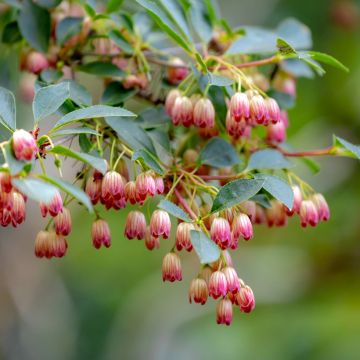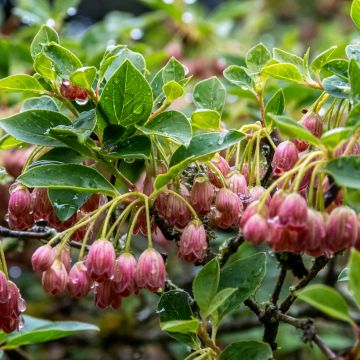

Enkianthus campanulatus Prettycoat


Enkianthus campanulatus Prettycoat


Enkianthus campanulatus Prettycoat
Enkianthus campanulatus Prettycoat
Enkianthus campanulatus Prettycoat
Redvein Enkianthus
Very beautiful, it has grown a lot... looking forward to seeing how it evolves in spring.
Béatrice, 29/10/2024
Special offer!
Receive a €20 voucher for any order over €90 (excluding delivery costs, credit notes, and plastic-free options)!
1- Add your favorite plants to your cart.
2- Once you have reached €90, confirm your order (you can even choose the delivery date!).
3- As soon as your order is shipped, you will receive an email containing your voucher code, valid for 3 months (90 days).
Your voucher is unique and can only be used once, for any order with a minimum value of €20, excluding delivery costs.
Can be combined with other current offers, non-divisible and non-refundable.
Home or relay delivery (depending on size and destination)
Schedule delivery date,
and select date in basket
This plant carries a 24 months recovery warranty
More information
We guarantee the quality of our plants for a full growing cycle, and will replace at our expense any plant that fails to recover under normal climatic and planting conditions.
Would this plant suit my garden?
Set up your Plantfit profile →
Description
Enkianthus campanulatus 'Prettycoat' is a variety with bright white flowers in spring. It forms a beautiful small bush with an erect habit, reaching a height of 1.2m (3 ft 11 in) and a width of 80cm (31.5 in), perfect for a small garden or planted in a pot! From April to June, it bears pendulous terminal clusters of small pure white, slightly fragrant campanulate bells, sheltered under small, oblong, shiny dark green leaves. Its upright branches with bright red bark create an interesting contrast with its dark foliage and white flowers. Before falling in autumn the leaves turn into beautiful shades of red-orange. The campanulate enkianthus thrives in partial shade or shade, in the company of rhododendrons and azaleas, in acidic, moist and humus-rich soil.
Native to Japan and southern China, Enkianthus campanulatus belongs to the family of ericaceae, just like heathers and Pieris to which it bears some resemblance. It is a deciduous bush that thrives in cool and humus-rich undergrowth, perfectly hardy but intolerant to limestone and dry soils.
The 'Prettycoat' cultivar is distinguished from the species mainly by its bright white flowers and reduced size. This slow-growing bush will reach on average 1.2m (3 ft 11 in) in height and 80cm (31.5 in) in width after many years. Its habit is unique, open and erect, almost columnar, dense and composed of regularly layered branches. The original flowering is one of the major assets of this plant. It appears for at least three weeks from April to June depending on the climate. The flowers are borne on short twigs located at the ends of branches, just below the foliage. The flowers are about 1.2cm (0.5 in) in diameter, slightly fragrant, pendulous and campanulate in shape and hang in dense clusters of 12 to 15 from slightly raspberry-tinted downy peduncles. They are pure white, very bright and nectar-rich. The deciduous foliage consists of small leaves, finely dentate along the edges, measuring 3 to 5cm (1.2 to 2 in) in length and 2cm (0.8 in) in width. They appear to be arranged in tiers at the ends of twigs, and are a shiny dark green from spring to summer. The undersides of the leaves are tinged with red along the veins. The autumn colours are a very bright red-orange.
This is a choice shrub for spaces with little light. The layered and erect habit of Enkianthus campanulatus 'Prettycoat' is exceptionally refined when planted in a pot on a terrace or as a specimen in a small garden. If you have more space, plant it in an ericaceous group under a grove of Japanese maples, accompanied by evergreen azaleas and camellias.
Report an error about the product description
Enkianthus campanulatus Prettycoat in pictures






Plant habit
Flowering
Foliage
Botanical data
Enkianthus
campanulatus
Prettycoat
Ericaceae
Redvein Enkianthus
Cultivar or hybrid
Other Enkianthus
View all →Planting and care
Enkianthus campanulatus likes semi-shaded exposures, sheltered from drying east winds. Plant it in a fresh but well-drained, light, humus-rich, fertile, and acidic soil. This bush does not tolerate limestone or drought. You can protect it in winter by covering the base with straw or dry leaves. This bush does not require pruning and is disease-resistant.
Planting period
Intended location
Care
-
, onOrder confirmed
Reply from on Promesse de fleurs
Haven't found what you were looking for?
Hardiness is the lowest winter temperature a plant can endure without suffering serious damage or even dying. However, hardiness is affected by location (a sheltered area, such as a patio), protection (winter cover) and soil type (hardiness is improved by well-drained soil).

Photo Sharing Terms & Conditions
In order to encourage gardeners to interact and share their experiences, Promesse de fleurs offers various media enabling content to be uploaded onto its Site - in particular via the ‘Photo sharing’ module.
The User agrees to refrain from:
- Posting any content that is illegal, prejudicial, insulting, racist, inciteful to hatred, revisionist, contrary to public decency, that infringes on privacy or on the privacy rights of third parties, in particular the publicity rights of persons and goods, intellectual property rights, or the right to privacy.
- Submitting content on behalf of a third party;
- Impersonate the identity of a third party and/or publish any personal information about a third party;
In general, the User undertakes to refrain from any unethical behaviour.
All Content (in particular text, comments, files, images, photos, videos, creative works, etc.), which may be subject to property or intellectual property rights, image or other private rights, shall remain the property of the User, subject to the limited rights granted by the terms of the licence granted by Promesse de fleurs as stated below. Users are at liberty to publish or not to publish such Content on the Site, notably via the ‘Photo Sharing’ facility, and accept that this Content shall be made public and freely accessible, notably on the Internet.
Users further acknowledge, undertake to have ,and guarantee that they hold all necessary rights and permissions to publish such material on the Site, in particular with regard to the legislation in force pertaining to any privacy, property, intellectual property, image, or contractual rights, or rights of any other nature. By publishing such Content on the Site, Users acknowledge accepting full liability as publishers of the Content within the meaning of the law, and grant Promesse de fleurs, free of charge, an inclusive, worldwide licence for the said Content for the entire duration of its publication, including all reproduction, representation, up/downloading, displaying, performing, transmission, and storage rights.
Users also grant permission for their name to be linked to the Content and accept that this link may not always be made available.
By engaging in posting material, Users consent to their Content becoming automatically accessible on the Internet, in particular on other sites and/or blogs and/or web pages of the Promesse de fleurs site, including in particular social pages and the Promesse de fleurs catalogue.
Users may secure the removal of entrusted content free of charge by issuing a simple request via our contact form.
The flowering period indicated on our website applies to countries and regions located in USDA zone 8 (France, the United Kingdom, Ireland, the Netherlands, etc.)
It will vary according to where you live:
- In zones 9 to 10 (Italy, Spain, Greece, etc.), flowering will occur about 2 to 4 weeks earlier.
- In zones 6 to 7 (Germany, Poland, Slovenia, and lower mountainous regions), flowering will be delayed by 2 to 3 weeks.
- In zone 5 (Central Europe, Scandinavia), blooming will be delayed by 3 to 5 weeks.
In temperate climates, pruning of spring-flowering shrubs (forsythia, spireas, etc.) should be done just after flowering.
Pruning of summer-flowering shrubs (Indian Lilac, Perovskia, etc.) can be done in winter or spring.
In cold regions as well as with frost-sensitive plants, avoid pruning too early when severe frosts may still occur.
The planting period indicated on our website applies to countries and regions located in USDA zone 8 (France, United Kingdom, Ireland, Netherlands).
It will vary according to where you live:
- In Mediterranean zones (Marseille, Madrid, Milan, etc.), autumn and winter are the best planting periods.
- In continental zones (Strasbourg, Munich, Vienna, etc.), delay planting by 2 to 3 weeks in spring and bring it forward by 2 to 4 weeks in autumn.
- In mountainous regions (the Alps, Pyrenees, Carpathians, etc.), it is best to plant in late spring (May-June) or late summer (August-September).
The harvesting period indicated on our website applies to countries and regions in USDA zone 8 (France, England, Ireland, the Netherlands).
In colder areas (Scandinavia, Poland, Austria...) fruit and vegetable harvests are likely to be delayed by 3-4 weeks.
In warmer areas (Italy, Spain, Greece, etc.), harvesting will probably take place earlier, depending on weather conditions.
The sowing periods indicated on our website apply to countries and regions within USDA Zone 8 (France, UK, Ireland, Netherlands).
In colder areas (Scandinavia, Poland, Austria...), delay any outdoor sowing by 3-4 weeks, or sow under glass.
In warmer climes (Italy, Spain, Greece, etc.), bring outdoor sowing forward by a few weeks.


































